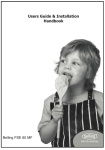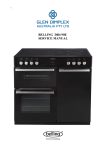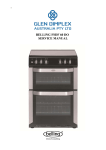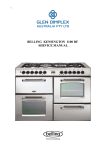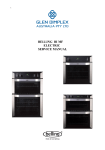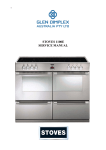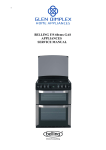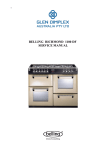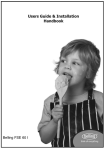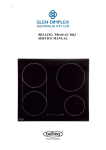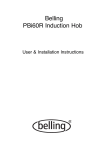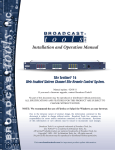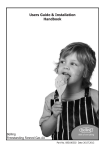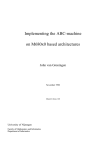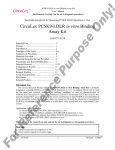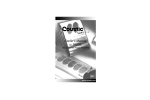Download Belling Hob Rotary UK Service manual
Transcript
1 BELLING FSE 60 I SERVICE MANUAL 2 INDEX PRODUCT IDENTIFICATION PAGE APPLIANCE RATING PLATE ............................................................. 3 USER GUIDE AND INSTALLATION HANDBOOK USER GUIDE.......................................................................................... INSTALLATION INSTRUCTIONS....................................................... TECHNICAL DATA............................................................................... WIRING DIAGRAMS............................................................................. CONTACT DETAILS............................................................................. PARTS LIST FSGE 60 I......................................................................... REPAIR AND MAINTAINANCE 4-47 47-51 52-52 53-54 59-59 60-65 DISASSEMBLY PROCEDURES.......................................................... COMPONANT REMOVAL.................................................................. TECHNICAL SPECIFICATIONS......................................................... FAULTFINDING GUIDES................................................................... INDUCTION TRAINING PRESENTATION....................................... 68-74 75-83 84-84 85-86 87-98 THIS MANUAL COVERS THE FOLLOWING MODELS :FSE 60 I 3 PRODUCT IDENTIFICATION Appliance rating plate location The appliance rating plate is located on the right-hand side of the front frame and also on the rear service panel 9 10 YEAR 4 1 8 MONTH 4 4 3 2 8 NUMBER OF PRODUCTION FOR THE MONTH 4 4 4 0 0 2 8 PRODUCT IDENTIFICATION CODE It is important that during all service calls the model and serial numbers are recorded on all paper work. Our Warranty Should you need it . . . . Inside the paperwork which has come with this appliance, there is a leaflet and card explaining the terms of our extended warranty and guarantee. In order to apply for our five year guarantee, simply fill in the details on the card and post it off, this will register your appliance. Should you wish to take out extended warranty, please fill in the details on the leaflet and post this off to: Glen Dimplex Australia Unit 2, 205 Abbotts Road Dandenong South Victoria 3175 Australia Ph: 1300 556 816 Fx: 1800 058 900 Glen Dimplex New Zealand Pty 38 Harris Road, East Tamaki Auckland New Zealand Ph: 09 274 8265 Fx: 09 274 8472 If your appliance is covered by the warranty and guarantee, you will not be billed for work undertaken should your appliance be faulty, terms and conditions do apply, so please read through the literature carefully. Please ensure that you have available your appliances model number and serial number, there is a space at the back of this book for recording that information. IMPORTANT NOTICE Please note the cooling fan fitted to this appliance is an integral part of its safety and functionality. When the appliance is installed care must be taken that the cooling fans performance is not impeded by any objects coming into contact with it. (Installation pipes, leads etc) Care must also be taken that there is sufficient air flow at the rear of the appliance for the cooling fan to run at its optimum efficiency. (Particularly Built In appliances) See clearance dimensions in the installation section of the booklet. During use the Appliance must never be disconnected from the Mains supply as this will seriously affect the safety and performance of the appliance, particularly in relation to surface temperatures becoming hot and gas operated parts not working efficiently. The cooling fan is designed to run on after the control knob has been switched off to keep the front of the appliance and the controls cool until the appliance has naturally cooled itself. CONTENTS User Section . . . . . . . . . . . . . . . . . . . . . . . . . . . . . . . . . . . . . . 2 - 42 Introduction . . . . . . . . . . . . . . . . . . . . . . . . . . . . . . . . . . . . . . . . . . . . . . . . . 2 Be Safe - Not Sorry. . . . . . . . . . . . . . . . . . . . . . . . . . . . . . . . . . . . . . . . . . . . 4 Using the induction hob. . . . . . . . . . . . . . . . . . . . . . . . . . . . . . . . . . . . . . . . . 7 Oven & Grill functions. . . . . . . . . . . . . . . . . . . . . . . . . . . . . . . . . . . . . . . . . 16 Using the grills . . . . . . . . . . . . . . . . . . . . . . . . . . . . . . . . . . . . . . . . . . . . . . 17 Using the top oven . . . . . . . . . . . . . . . . . . . . . . . . . . . . . . . . . . . . . . . . . . . 20 Using the multi-function main oven . . . . . . . . . . . . . . . . . . . . . . . . . . . . . . . . 23 Using the main oven . . . . . . . . . . . . . . . . . . . . . . . . . . . . . . . . . . . . . . . . . . 24 Using the ovens . . . . . . . . . . . . . . . . . . . . . . . . . . . . . . . . . . . . . . . . . . . . . 31 Programmer/Clock . . . . . . . . . . . . . . . . . . . . . . . . . . . . . . . . . . . . . . . . . . . 35 Care & cleaning . . . . . . . . . . . . . . . . . . . . . . . . . . . . . . . . . . . . . . . . . . . . . 40 Installation Instructions . . . . . . . . . . . . . . . . . . . . . . . . . . . . . . . . . 43 Technical Data . . . . . . . . . . . . . . . . . . . . . . . . . . . . . . . . . . . . . . . 47 Belling Customer Care . . . . . . . . . . . . . . . . . . . . . . . . . . . Back page Please keep this handbook for future reference, or for anyone else who may use the appliance. 1 INTRODUCTION Thank you for choosing a British built appliance by Belling. Moving the cooker Do not attempt to move the cooker by pulling on the doors or handles. Open the oven or grill door and grasp the frame of the cooker, taking care that the door does not shut on your fingers. We hope that the following information will help you to quickly familiarise yourself with the features of the appliance, and to use it successfully and safely. Take care to avoid damage to soft or uneven floor coverings when moving the appliance. Some cushioned vinyl floor coverings may not be designed to withstand sliding appliances without marking or damage. Our policy is one of constant development and improvement. Strict accuracy of illustrations and specifications is not guaranteed. Modification to design and materials may be necessary subsequent to publication. Before using the appliance for the first time, remove any protective polythene film and wash the oven shelves and shelf runners in hot soapy water to remove their protective coating of oil. Even so, when you first turn on the oven or grill you may notice a smell and some smoke. This cooker may be sited with cabinets on both sides, or it may be free standing. Sufficient space should be allowed at either side of the cooker to enable it to be pulled out for cleaning and servicing. Glass door panels To meet the relevant Standards of Domestic cooking appliances, all the glass panels on this appliance are toughened to meet the fragmentation requirements of BS3193. This ensures that, in the unlikely event that a panel breaks, it does so into small fragments to minimise the risk of injury. Please take care when handling, using or cleaning all glass panels, as any damage to the surfaces or edges may result in the glass breaking without warning or apparent cause at a later date. Should any glass panel be damaged, we strongly recommend that is is replaced immediately. Please read the instructions in this handbook before using or installing this appliance. All installation and servicing work must be carried out by a competent person. Your 1st Year Guarantee To fulfil the conditions of your guarantee, this appliance must be correctly installed and operated, in accordance with these instructions, and only be used for normal domestic purposes. Please note that the guarantee, and Service availability, are only available in the UK and Republic of Ireland. 2 INTRODUCTION The cooling fan Electrical connection When the appliance is operated, the cooling fans will automatically operate. This keeps the facia, control knobs and components cool during cooking. Please refer to installation instructions for electrical connection. The cooling fan may continue to operate for a period of time after the controls have been switched off. Disconnection of electric appliances should always be carried out by a competent person. When hot and cold air meet, condensation forms. Some condensation may form on doors or on the fascia glass. This is normal and will disappear within 10 - 15 minutes. Warning: This appliance must be earthed. In your own interest, and that of safety, make sure that the installation is carried out by a competent person. To replace an oven light bulb Caution: Switch off the electricity supply to the cooker at the socket, to avoid the risk of electric shock. Environmental Protection We are committed to protecting the environment and operate an Environmental Management System which complies with BS EN ISO 14001. Wait until the oven is cool, then remove the shelves. The oven light is at the rear of the oven cavity. Remove the loose oven back - unscrew the 4 securing screws (one at each corner). Disposal of packaging • All our packaging materials are recyclable and environmentally friendly. • Please help us to protect our environment by disposing of all packaging in an environmentally friendly manner. • Unscrew the lens cover (turn anticlockwise). Unscrew the bulb and replace. Replace lens cover. Replace oven back. Please note that the oven light bulb is not covered by the guarantee. Replacement bulbs can be ordered from your local supplier, or bought from a hardware store. Please contact your local authority for the nearest recycling centre. Caution: Packaging materials can pose a risk of suffocation - keep away from children. 3 BE SAFE - NOT SORRY When you are cooking, keep children away from the vicinity of the appliance. • Keep electrical leads short so they do not drape over the appliance or the edge of the worktop. This product is designed as a domestic cooking appliance for the preparation and cooking of domestic food products, and should not be used for any other purpose. • Keep all flammable materials (such as curtains, furnishings & clothing) away from the appliance. • Never use the appliance for heating a room. • Parts of the appliance may be hot during or immediately after use. Care should be taken to avoid touching heating elements inside the oven. Allow sufficient time for the appliance to cool after switching off. • Do not use the oven with the door inner glass panel removed. • Make sure you read and understand the instructions before using the appliance. • Remove all packaging, protective films and oils from the appliance before using for the first time. • Before using the hob for the first time, remove all packaging, protective films, oils and stickers from the glass ceramic. • Apply a thin coating of cleaner conditioner and polish the surface with a clean dry cloth. • Do not drape tea towels over the flue vents or doors, as this creates a fire hazard. • The conditioner gives a protective covering to the ceramic glass which not only makes the hob eiser to clean, but also ensures you will gain maximum life out of this product. • Switch off the electricity supply before replacing the oven light bulb, to avoid the risk of electric shock. • Do not use aluminium foil to cover the grill pan, or put items wrapped in foil under the grill, as this creates a fire hazard. The high reflectivity can also damage the element. • Do not use foil on oven shelves, or allow it to block the oven flue, as this creates a fire hazard, and prevents heat circulation. • • Risk of burns - do not place objects made of steel, such as knives, forks, spoons and saucepan lids on the cooking surface, as they can get very hot. Warning! do not clean the appliance with a steam jet or high-pressure cleaning equipment. 4 BE SAFE - NOT SORRY • • When cooking heavy items - eg; turkeys - do not pull the oven shelf out with the item still on the shelf. When opening the appliance door, take care to avoid skin contact with any steam which may escape from the cooking. • Use oven gloves when removing hot food / dishes from the oven or grill. The oven / grill and utensils will be very hot when in use. • The glass ceramic can get hot whilst cooking; the cook zone itself does not generate heat. The heat generated is conducted back from the hot pans. • This induction hob complies with the applicable EMC and EMF standards. Therefore it should not interfere with other electronic units. Persons fitted with a pacemaker or any other electrical implant should clarify with their doctor or the producer of the implant, whether there implant is adequate and fail-safe, the pacemaker must be designed in compliance with the appropriate regulations. • • oven gloves to protect your hands. • Don't leave pans on the hob when you're not around - take them off the cook zone if you have to leave the kitchen (even if you think it will only be for a moment) • If you're called away from the cooker - by the phone or someone at the door, either take pans off the heat or switch off your hob. Warning! Do not use the hob if the ceramic glass surface is cracked or broken, as electrica l parts are immediately beneath. Switch of the appliance at the supply and contact your supplier Warning: This appliance must be earthed. • All installation, servicing and maintenance work should be carried out by a competent person who will comply with curre nt Regulations, Standards and Requirements. • When you have finished cooking check that all controls are in the off position. WARNING! -Accesible parts may become hot during use. To avoid burns, young children should be kept away from the appliance. It’s important that good quality flat bottomed pans are used, if a pan creates a large air gap over the middle of the cooking zone, the accuracy of the temperature sensing can be affected. Call Customer Care for a Service Engineer's visit if: You find that the oven becomes hotter at a particular temperature - the thermostat may need replacing. The Cooling fan fails to work If you use a griddle plate ensure it is completely cool before attempting to lift it from the hob as residual heat may cause burns. Always use 5 BE SAFE - NOT SORRY guish the fire, allow the pan to cool completely. Smoke alarm - buy a smoke alarm fitted with a ‘hush button’ which can silence the alarm instantly should it activate accidentally & does not necessitate the removal of the battery (except to change for a new one). Electrical Fire - if you have an electrical fire in the kitchen: 1) pull the plug out or switch off the power at the fuse box - this may be enough to extinguish the fire immediately 2) smother the fire with a fire blanket or use a dry powder or carbon dioxide extinguisher 3) remember: never use water on an electrical fire. Fire Blanket - consider having a fire blanket in your kitchen, mounted on the wall where you can get to it easily & quickly. Deep-fat Frying - never fill a chip pan (or other deep-fat fryer) more than one-third full of oil. If you do have a chip pan fire: 1) call emergency services 2) never move the pan 3) turn off the heat but only if it is safe do so 4) never use water on a chip pan fire as this will create a fireball. Kitchen Fire - if you have a fire in the kitchen, do not take risks - get everybody out of the house & call Emergency services. If a pan catches fire: 1) do not move it - it is likely to be very hot 2) turn off the heat but only if safe to do so & never lean over a pan to reach the controls 3) if you have a fire blanket, put it over the pan 4) do not use a fire extinguisher on a pan of oil - the force of the extinguisher can spread the fire 5) if you have managed to extin- Children should be supervised to ensure that they do not play with the appliance. This appliance is not intended for use by persons (including children with reduced physical, sensory or mental capabilities, or lack of experience and knowledge) unless they have been given supervision or instruction concerning use of the appliance by a person responsible for their safety. WARNING:- Servicing should be carried out only by authorised personnel. Do not spray aerosols in the vicinity of this appliance while it is in operation Do not store or use flammable liquids or items in the vicinity of this appliance. Do not modify this appliance. 6 USING THE HOB Using the hotplate • Commerc ial simmering aids should not be used as they create excessive temperatures that can damage the surface and may cause a hazard. • Do not place aluminium foil or plastic utensils on the ceramic glass, as they may melt and damage the surface. • Do not use the ceramic glass hotplate surface for storage. • When cooking with fat or oil, never leave unattended. • Turn pan handles to a safe position, so they are out of reach of children, not overhanging the appliance, and cannot be caught accidentally. • Position pans over the centre of the hotplate elements. • Do not use the hob as a chopping board or a storage area, as this increases the likelihood of it being damaged - eg; plastic utensils placed on a warm hob may melt onto it, and damage the ceramic glass surface. • Be careful when cooking foods in salted water, or foods containing large amounts of sugar, syrup or jam - if they are spilt onto hot areas of the hob they may damage it. 7 • Lift pans onto and off the surface, rather than sliding them across the surface , to avoid marks and scratches. • If you use a wet paper towel to remove spills from a warm heating area of the hob, be careful to avoid steam burns. • Do not use abrasive powder cleaners, metal wire wool pads, impregnated plastic pads, detergents, bleaches, bath stain removers, or chemical oven cleaners; all these types of products will damage the ceramic glass. INDUCTION HOB FUNCTIONS Feature Symbol Description Eco Power Induction Power is the most energy efficient means of cooking food on a hob, provides fast heat up and boiling times Rotary Controls Simple knob control with all the benefits of induction technology Digital Display Secret till "lit" hob display No. of power levels 11 Precise and repeatable control settings Keep Warm/ Low Temperature Holds the pan temperature at approximately, ideal for melting chocolate “mmmm choc-ol-ateee” Auto Heat Up (4 Zones) Automatically heats up and turns down the power to a lower setting. Helps to take the worry out of pans boiling over and burning food Temporarily boost the power to a cook zone by a massive 60% Power Boost Griddle zone Yes Flexibility is what counts. Place pans across the LH cook zones. This is ideal for large griddle plates and pans Lets you know if the correct pans are being used and helps to save energy. When a pan is lifted off the zone, the power is automatically cut. Pan Detection Overheat Pan Detection Yes Helps prevent cookware from overheating providing an additional level of safety not availabe on other types of hobs Child lock L Prevents unintentional operation of the hob Warns you against hot surfaces but also indicates that there is residual heat which can be used as a temporary warm zone Residual Heat Indicators Holiday Shutdown Yes Rest assured this hob will eventually turn it self off if left 8 USING THE INDUCTION HOB About the induction hob The induction hob provides the most energy efficeint hob technology available. The induction system provides superior heat up and cool down times for pans - you get fast, precise, repeatable power control. As induction only heats up the pan, there is no lost heat from the cooking process, which in turn, limits the heat generated in the kitchen. Auto Power Tuning Induction hobs have a unique power tuning systems that automatically tunes the power to the size of the pan base this ensures energy isn’t wasted. Small Pan Large Pan 9 USING THE INDUCTION HOB Induction controls To turn the hob ‘ON’ / ‘OFF’ To turn the hob ‘ON’ turn the control knob clockwise to set the cook zone to the desired power setting (1 to 9). The power display will automatically light up. To turn the hob ‘OFF’ turn the control knob anti-clockwase to the ‘OFF’ position. Auto Heat Up Helps to take the worry out of pans boiling over and burning food! No need to stand over the pan, allows you to do other tasks whilst maintaining control over the pan. The Auto Heat Up is activated by rotating he control knob anti-clockwise and holding for a couple of seconds until the symbol lights up in the display area, then by rotating the control knob to the required turn down setting. The Auto Heat Up delivers full power (9) to the zone for a fixed period of time before automatically turning back down to the desired setting. The Auto Heat Up has been tuned to provide the best boost period for each setting. Average Auto Heat up time is 3 minutes. Power Setting Low temp U ˚C Suggested food type Auto Heat Up time (mins) Melting chocolate n/a 1 2 3 Milk, Soup Stews, Vegetables 1 2.5 4 4 5 Rice, Potatoes, Pasta 6 7 8 9 Frying, fish fingers Pancakes, Steaks Boost Full power Full power +60% 10 5 7 2 3 4 n/a n/a USING THE INDUCTION HOB Power Boost Rev up your hob with this feature, temporarily boost the power to a cook zone by a massive 60%. Note The Power Boost function will only operate for a limited time and is also under thermal control. This means the power boost will deactivate automatically if the product is hot, to protect the internal electronic components of the hob and to prevent the cookware from overheating. The power boost is a function that can be used to temporally boost the normal maximum power for a cook zone by borrowing the available power from a “paired zone”. All the cook zones have this function apart from the “Griddle Zone ” function. The Power Boost is activated by rotating the control knob clockwise past power setting 9 and holding for a couple of seconds until lights up in the display area. Power Boost is now activated. The hob is split into “two paired areas”. LH Area (LHF and LHR Cook Zone) and RH Area (RHF and RHR Cook Zone). Only one cook zone per area can be boosted at anyone time. LHF 1.85 3.00 Maximum Permissable Setting on Paired Zone 8 (LHR) LHR 1.85 3.00 8 (LHF) RHF 1.40 2.20 8 (RHR) RHR 2.30 3.70 6 (RHF) Cook Zone Normal Max Power (9) kW Boosted Power kW 11 USING THE INDUCTION HOB Pan detection Griddle Zone When a zone has been activated but no pan has been placed on the cook zone, this means the hob only uses power when a suitable pan is placed on the zone, this reduces the energy used during the cooking process, i.e. when you take your pan off the zone the hob automatically reduces the power, and only switches back on when you replace the pan. Flexibility is what counts. Note If the symbol does not disappear when a pan is placed on the zone it indicates that the pan is not suitable for induction cooking. The LH zones can be used as two separate round cooking zones which can be controlled individually creating a hot and cold zones on a griddle or the power settings can be matched to provide an even heat. Get a magnet to check the pans. Pan Sizes Large pans and griddle plates can be placed across the two zones. Cook Zone Smallest Recommended Pan Diameter Keep Warm LHF 145 mm The Keep Warm setting is found between power setting 0 and 1. Rotate the control knob clockwise until the symbol appears on the display. LHR 145 mm RHF 120 mm RHR 180 mm 12 USING THE INDUCTION HOB Cookware for induction hobs Cookware for induction cooking zones must be made of metal and have magnetic properties. The base must also be the correct diameter. Suitable Cookware for Induction Hobs Unsuitable Cookware Enameled steel pots with a thick base Pots made of copper, Cast Iron posts with an enameled base stainless steel, aluminium, oven-proof glass, wood Pots made of multilayer stainless steel, ceramic and terracotta rustproof ferrite steel or aluminium with a special base Pans marked for use with induction How to establish the suitability of a pan Check your pans with a magnet. If it sticks and it’s the correct diameter, it’s suitable for use with induction. Also with pans that bear the symbol for suitability for cooking with induction. Note - when using certain pans, you may get various noises from the pans. This is due to the design of the pans and does not effect the performance or safety of the hob. 13 USING THE INDUCTION HOB ing an additional level of safety not available on conventional hobs (such as gas and ceramic hobs). Child Lock Stops the “kids” messing with your lovely induction hob. This feature is to help prevent accidental switching on of the hob, especially by young children. To activate/deactivate, simultaneously rotate the Left Hand Rear and Right Hand Rear control knobs to the Auto Heat Up setting for a couple of seconds. will light up in the display area for all cook zones to show activation. Follow the same procedure to deactivate and the symbol will disapear from the display area. Approx. Glass Surface Temperature (Approx ˚C) 200 250 Intelligent hob safety system Reduces Power Boost setting to Power Level 9 Reduces power to 60% of power level setting 270 Switches cook zone off 300 Switches whole appliance off Note - The safety temperature control of the pans is only possible with quality flat bottomed pans suitable for induction cooking. Poor quality pans can create air gaps between the glass and the pan, which affects the accuracy of the temperature control. Residual Heat indicators If when the cook zone is switched off the glass surface is above 60˚C , H will be displayed in the cook zone display until the glass surface drops below approx 55˚C. Auto Stand by (Holiday Shut Down) Have you ever gone on holiday and wondered if you have switched off the hob? No need to worry about leaving your hob on with the most advanced cooking system available the hob will automatically switch itself off if left unattended. This feature not only warns you against hot surfaces but also indicates that there is residual heat which can be used as temporary warm zone. Note - The cook zone itself does not heat up, but the ceramic glass does get hot because of the hot pan conducting heat back onto the hob glass. Overheat Pan Protection The hob is equipped with additional safety systems that help to prevent cookware from overheating, provid 14 USING THE INDUCTION HOB Troubleshooting with the Induction Hob Code Problem ER21 Possible Cause Solution Hob is not working in display Child lock is activated Deactivate child lock Power boost not working The appliance is hot, power boost is deactivated when the appliance is hot to protect the electronics and prevents pans from overheating Allow the appliance to cool Control unit cuts off after program setting Electronics overheating Allow the appliance to cool ER400 Check mains cable connection and terminals at the terminal block are wired correctly E2 Overheating of induction coil Pan overheating Remove pans and allow to cool E8 Fan blocked or faulty Fan inlets are blocked or faulty fans Clean fan inlet at the rear of the appliance 15 OVEN & GRILL FUNCTIONS Function Recommended Uses Base Heat Only Used to finish off the bases of food following cooking using the conventional or fanned modes. The base heat can be used to provide additional browning for pizzas, pies and quiche. Use this function towards the end of cooking. Top Heat Only The heat is ideal for browning off the tops of food as it is not as fierce as the grill following conventional or fanned cooking. Provides additional browning for dishes like lasagne or cauliflower cheese. Use this function towards the end of cooking. Conventional Oven This function is ideal for traditional roasting, The meat is placed in the middle of the oven, roast potatoes towards the top. Intensive Bake (Pizza Setting) Ideal for pizzas and also suitable for food with a high moisture content, such as quiche, bread and cheesecake. It also eliminates the need for baking pastry blind. Fanned Grill The fan allows the heat to circulate around the food. Ideal for thinner foods such as bacon, fish and gammon steaks. Foods do not require turning. Use with the oven door closed. Fanned Oven The even temperature in the oven makes this function suitable for batch baking or batch cooking foods. Defrost To defrost foods, such as cream cakes/gateaux, use with the oven door closed. For cooling dishes prior to refrigeration, leave the door open. Dual Grill This function cooks food from the top and is ideal for a range of food from toast to steaks. As the whole grill is working, you can cook larger quantities of food. Single Grill For smaller quantities of food, but is still ideal for anything from toast to steaks. Base Heat with Fan Used to cook open pies (such as mince pies) the base element ensures that the base is cooked while the fan allows the air to circulate around the filling - without being too intensive. 16 USING THE GRILLS Caution: Accessible parts may be hot when the grill is used, young children should be kept away. Detachable grill pan handle grid Using the grills This appliance has a grill in both oven cavities. The top oven grill is a fully variable dual element grill. The main oven features variable grilling - with a single element conventional grill, and a fanned grill function. grill pan handle Follow the instructions given on the next page when operating these grills. handle position indicators Place the handle over the edge of the grill pan, at the narrow side edges. Slide the handle to the centre, and locate between the handle position indicators. Preheating For best results, preheat the grill for 3 - 5 minutes. Aluminium foil Using aluminium foil to cover the grill pan, or putting items wrapped in foil under the grill can create a fire hazard, and the high reflectivity can damage the grill element. The handle should be removed from the pan during grilling, to prevent overheating. The handle is designed for removing / inserting the grill pan under the grill when grilling. If cleaning the grill pan when it is hot, use oven gloves to move it. Do not use the handle to pour hot fats from the grill pan. Food for grilling should be positioned centrally on the trivet. 17 USING THE GRILLS Grilling in the top oven Using the top oven grill Caution: Accessible parts may be hot when the grill is used, young children should be kept away. For grilling smaller quantities of food the (single element) economy grill can be utilised. This grill function can be controlled between settings 1 and 8. The top oven grill is a fully variable dual element grill. For grilling larger quantities the (dual element) full grill utilised. The full grill can controlled between settings 1 To switch on the grill of food, can be also be and 8. When using the grill in the top oven, the speed of grilling can be controlled by use of either the variable control or by selecting higher or lower shelf position. Open the top oven / grill door. Turn the top oven control knob past the oven temperature markings to either the single economy grill symbol, or the dual grill symbol. For toasting, and for grilling foods such as bacon, sausages or steaks, use a higher shelf position. The grill regulator - to the left of the top oven control - must then be switched on. This enables variation of the heat output from the grill on either the single grill or dual grill settings. For thicker foods such as chops or chicken joint pieces, use a middle to low shelf position. The dual grill uses all of the top element, and the single economy grill setting uses the inner part of the element only. The cooling fan When the grill is switched on, you will hear the cooling fan come on - this keeps the fascia and control knobs of the appliance cool during grilling. The fan may continue to operate for a period after the grill control has been switched off. Important: The door must be kept open when the grill is used. To switch off, return the control knob to the “off” position. Note that the grill will not operate if the top oven is switched on. 18 USING THE GRILLS Grilling in the main oven Fanned grill Caution: Accessible parts may be hot when the grill is used young children should be kept away. The door must be closed when the fanned grill is used. When opening the door, take care to avoid skin contact with any steam which may escape from the cooking. The grill / fanned grill settings use the inner element only. (i) Turn the selector control knob to the fan grill setting. Conventional grill (ii) Turn the temperature control knob to the desired temperature up to 230˚C. The door must be closed when the grill is used for conventional grilling. Fanned grilling may be faster than conventional grilling because air is being circulated around the food. Thin portions of food, such as bacon or fish fillets, may not need turning. When opening the door, take care to avoid skin contact with any steam which may escape from the cooking. (i) Turn the selector control knob to the conventional grill setting. For best results, preheat the grill for 3 - 5 minutes. (ii) Turn the temperature control knob to the desiredtemperature for grilling, similar to oven function. However, do not set to a temperature greater than 230˚C. Note that when grilling, the door must remain closed before and after grilling, and the temperature control must not exceed 230˚C. Grilling in the main oven The speed of grilling can be controlled by selecting a higher or lower shelf position. For toasting, and for grilling foods such as bacon, sausages or steaks, use a higher shelf position. For thicker foods such as chops or chicken joint pieces, use a middle to low shelf position. 19 USING THE TOP OVEN When you are cooking keep children away from the vicinity of the oven. The cooling fan When the top oven is switched on, you will hear the cooling fan come on - this keeps the fascia and control knobs of the appliance cool during cooking. The fan will continue to operate for a period after the oven control has been switched off. Caution: The top element gets extremely hot when in use, so take extra care to avoid touching it. The top oven is a conventional oven Note: The top oven is not controlled by the programmer. Preheating The oven must be preheated when cooking frozen or chilled foods, and we recommend preheating for yeast mixture s, batters, soufflés, and whisked sponges. To turn on the top oven Turn the temperature control knob clockwise until the required temperature is selected. The red thermostat indicator will come on until the selected temperature is reached, and then go off; it will turn on and off peri odica lly as the thermostat operat es to maintain the selected temperature. Preheat the oven until the indicator light switches off for the first time, this will take up to 20 minutes depending on the temperature selected. If you are not preheating the oven, the cooking times in the following guide may need to be extended, as they are based on a preheated oven. To switch off, return the top oven control knob to the off position. Important: Never put items directly on the base of the oven, or cover the oven base with foil, as this may cause the element to overheat. Always position items on the shelf. Top heat only Turn the top oven selector past the oven temperature markings to the top heat symbol. This fixed heat setting can be used to brown the top of dishes such as cauliflower cheese or baked alaska. 20 USING THE TOP OVEN Shelf positions There are 2 shelf positions which are counted from the bottom of the oven upwards, so shelf position 1 is the lowest. When cooking frozen or chilled food, use the highest possible shelf position, while allowing some clearance between the food and the top element. The oven shelf must be positioned with the upstand at the rear of the oven and facing up. Position baking trays and roasting tins on the middle of the shelves, and leave one clear shelf position between shelves, to allow for circulation of heat. When using the top oven As part of the cooking process, hot air is expelled through a vent at the top of the oven(s). When opening the oven door, care should be taken to avoid any possible contact with potentially hot air, since this may cause discomfort to people with sensitive skin. We recommend that you hold the underneath of the oven door handle. 21 Using the Top Oven Cooking temperatures Top oven baking guide The temperature settings and time given in the Baking Guides are based on dishes made with block margarine. If soft tub margarine is used, it may be necessary to reduce the temperature setting. If a recipe gives a different temperature setting to that shown in the guide, the recipe instruction should be followed. Cooking times These times are based on cooking in a preheated oven. These cooking times are approximate, because the size and type of cooking dish will influence time as well as personal preferences. Shelf positions Because the top oven is more compact, it may be necessary to reduce cooking temperatures specified in recipes by up to 20˚C. As a general guide, when cooking frozen or chilled food, use the highest possible shelf position, while allowing some clearance between the food and the top element. Follow the instructions given on packaging. Use the baking guide as a reference for determining which temperatures to use. Item Temperature ˚C Shelf position Approximate cooking time Small cakes Victoria sandwich (2 x 180mm / 7”) Swiss roll Semi rich fruit cake (180mm x 7”) Scones Meringues 180 160 1 1 15 - 20 mins 20 - 25 mins 200 140 1 1 8 - 12 mins 21⁄4 - 23⁄4 hours 215 90 - 100 1 1 10 - 15 mins 2 - 3 hours Shortcrust pastry Puff / flaky pastry Choux pastry 200 - 210 200 - 210 200 - 210 1 1 1 Depends on size & type of cooking dish & also the filling Biscuits Sponge pudding Milk pudding 160 - 200 150 140 2 1 1 10 - 20 mins 30 - 45 mins 2 - 21⁄2 hours 22 USING THE MULTI-FUNCTION MAIN OVEN Caution: Accessible parts may be hot when the oven is used, young children should be kept away. Step 1 - Select the function The main oven is a multi-function oven, and may be used as a conventional oven or a fanned oven. It may also be used as a grill, or with one of the other oven functions. Step 2 - Set the main oven control To turn on the main oven Turn the selector control knob in either direction, until the function you require is selected. If you have selected an oven cooking function, then simply turn the main oven control knob clockwise to the required temperature - this brings on the neon indicator light, which will stay on until the oven reaches the required temperature. Manual operation The programmer must be set to manual operation before the main oven or grill functions can be used. If A (Auto) is on the programmer display, return the oven to manual operation by pressing the plus and minus buttons simultaneously. Any programme which has been set is cancelled. If you have selected defrost, do not turn the thermostat control on. To switch off the main oven, return the control knobs to the ‘off’ position. Automatic operation Baking tray and roasting tins See ‘Programmer / Clock’ section. For best cooked results and even browning, the maximum size baking trays and roasting tins that should be used are as follows; Baking tray 350mm x 280mm This size of baking tray will hold up to 16 small cakes. Roasting tin 370mm x 320mm We recommend that you use good quality cookware. Poor quality trays and tins may warp when heated, leading to uneven baking results. 23 USING THE MAIN OVEN Oven cooking Preheating (conventional mode) Caution: Accessible parts may be hot when the appliance is in use - keep children away from the vicinity of the oven. When using the conventional mode to cook sensitive items such as scouffle’s and Yorkshire puddings or, when cooking bread, we recommend that the oven is pre-heated until the neon switches off for the first time. For any other types of cooking, a pre-heat is not required. Never put items directly on the base of the oven or cover the oven base with foil, as this can cause the base element to overheat. Always use the fan oven setting for preheating to save time and electricity. Manual operation Set the programmer to manual operation. See ‘Programmer / Clock’ section. After the oven has been preheated on the fan oven setting, turn the selector control knob to the oven setting you require. Turn the selector control knob until the symbol for the desired oven function is selected. Preheat the oven until the indicator neon switches off for the first time; this will take between 5 - 15 minutes, depending on the temperature selected. Turn the main oven control knob to the desired temperature. The red thermostat indicator neon will come on until the selected temperature is reached, then go off. It will cycle on and off as the thermostat operates to maintain the selected temperature. When using the oven As part of the cooking process, hot air is expelled through a vent at the rear of the oven. When opening the oven door, care should be taken to avoid any possible contact with potentially hot air, since this may cause discomfort to people with sensitive skin. We recommend that you hold the underneath of the oven door handle. To switch off the main oven, return the main oven control knob to the “off” position. Automatic operation See ‘Programmer / Clock section. Oven shelves The oven shelf must be positioned with the upstand at the rear of the oven and facing up. The cooling fan Position baking trays and roasting tins on the middle of the shelves, and leave one clear shelf position between shelves, to allow for circulation of heat. The cooling fan may operate when the main oven is on and may continue to operate for a period after the oven has been switched off. 24 USING THE MAIN OVEN Fan oven Base heat only (i) Turn the selector control knob to the fan oven symbol. (i) Turn the selector control knob to the base heat symbol. (ii) Turn the temperature control knob to the required temperature. (ii) Turn the temperature control knob to the required temperature. The fan oven comes on when the oven is switched on and circulates the air around the oven to give a fairly even temperature throughout the oven. This setting can be used to finish cooking pastry bases, pies or pizzas etc. Fan and base heat only Conventional oven (i) Turn the selector control to the fan and base heat symbol. (i) Turn the selector control knob to the conventional oven symbol. (ii) Turn the temperature control knob to the required temperature. (ii) Turn the temperature control knob to the required temperature. This setting can be used to finish items without a top crust - eg; jam tarts, open mince pies and flans. The temperature you select corresponds to the temperature in the middle of the oven. Intensive bake (Pizza setting) The top heat comes from the outer element of the grill, and the base heat is under the oven base. (i) Turn the selector control to the intensive bake symbol. (ii) Turn the temperature control to the required temperature. Top heat only (i) Turn the selector control knob to the top heat symbol. This setting is ideal for pizzas and also for items with a high moisture content eg; fruit flans, quiches and cheese cake. (ii) Turn the temperature control to the required temperature. This setting can be used to brown the top of dishes such as cauliflower cheese or baked alaska etc. 25 USING THE MAIN OVEN Cooking with a fanned oven Notes: As this is a high efficiency oven, you may notice the emission of steam from the oven when the door is opened. Please take care when opening the door. When 2 or more shelves are being used, it may be necessary to increase the cooking time slightly. Because the 2 oven shelves are wider than in many ovens, it is possible to cook 2 items per shelf - eg; 2 victoria sandwiches or 2 casseroles. Although you need to keep in mind the point from the previous page ‘To help the air circulate freely’ with careful choice of dishes and tins, it is possible to cook a complete meal and perhaps something else for the freezer in the oven at the same time. If you have been used to cooking with a conventional oven, you will find a number of differences to cooking with a fanned oven, which will require a different approach: There are no zones of heat in a fanned oven, the convection fan at the back of the oven ensures an even temperature throughout the oven. This makes it ideal for batch baking - eg; when planning a party or stocking the freezer, as all items will be cooked within the same length of time. When roasting meats, you may notice that fat splashing is reduced, which is due in part to the lower oven temperatures, and will help keep cleaning of the oven to a minimum. Foods are cooked at a lower temperature than a conventional oven, so conventional recipe temperatures may have to be reduced. Please refer to the conversion chart. Because a fan oven has an even temperature throughout the oven, no shelf positions have been given in the following baking guide, and there is no need to interchange dishes onto different shelves part way through cooking, as with a conventional oven. Pre-heating is generally not necessary as a fan oven warms up quickly. There is no flavour transference in a fan oven, which means you can cook strong smelling foods such as fish at the same time as mild foods - eg; milk puddings. When batch baking foods that will rise during cooking - eg; bread - always ensure that enough space has been left between shelves to allow for the rise. 26 USING THE MAIN OVEN Main oven baking guide To help the air circulate freely • Position the shelves evenly within the oven and maintain a clearance from the oven roof and base. • If more than one cooking dish or baking tray is to be used on a shelf, leave a gap of at least 25mm between the items themselves and the oven interior. • Allow enough space between shelves for food that will rise during cooking. • Cooking times These times are based on cooking in a preheated oven. The cooking times given are only approximate because the size and type of cooking dish will influence cooking time, a s w i l l p e r s o n a l preference. Cooking temperatures • The temperature settings and times given in the baking guide are based on dishes made with block margarine. • If soft tub margarine is used it may be necessary to reduce the temperature setting. • If a recipe gives a different temperature setting to that shown in the guide, the recipe instruction should be followed. Do not place items on the oven base as this will prevent air from circulating freely. 27 MAIN OVEN CONVERSION GUIDE Note: this is a high efficiency oven, therefore some adjustment will have to be made to conventional cooking temperatures when using the fanned oven. The table below shows conventional cooking temperatures, fanned oven temperatures and gas marks. For optimum results, conventional temperatures need to be converted to fanned temperatures. For example, an item which would normally cook at a conventional temperature of 180 ˚C, will now cook at the fanned temperature of 160˚C. Conventional temperature (˚C) Fanned Oven (˚C) Gas Mark 100 100 1/4 110 110 1/4 130 120 1/2 140 130 1 150 140 2 160 150 3 180-190 160 4-5 200 170 6 220 180 7 230 190 8 250 200 9 28 USING THE OVENS Baking guide Dish Scones Meringues Cakes Small cakes Whisked sponge Swiss roll Victoria sandwich (2 x 180mm / 7”) Genoese sponge Madeira (180mm / 7”) Semi rich fruit cake (205mm /8”) Christmas cake (205mm / 8”) Dundee cake (205mm / 8”) Pastry Flaky / Puff Shortcrust Choux Plate tarts (2 x 180mm / 7”) Biscuits Shortbread rounds Nut brownies Brandy snaps Flapjacks Ginger nuts Recommended temperature ˚C Fanned Conventional Suggested shelf position (counted from bottom up) 180 110 220 110 3&5 1 160 160 170 160 190 190 200 180 2&4 3 3 3 160 160 130 180 180 150 3 2 2 20 - 25 mins 1hr - 11⁄4 hrs 21⁄2 - 3hrs depending on recipe 130 150 2 depending on recipe 21⁄2 - 3hrs 2 180 170 170 170 220 200 200 200 top top top top - middle middle middle middle 160 170 160 160 160 190 200 180 180 180 top top top top top - middle middle middle middle middle 29 Approximate cooking time (preheated oven) 8 - 15 2 - 3 hrs 15 15 10 20 - 25 20 12 30 mins mins mins mins depending on recipe and type of filling 20 20 10 20 10 - 25 25 12 25 20 mins mins mins mins mins USING THE MAIN OVEN Cooling and defrosting in the main oven • To cool foods after cooking prior to refrigerating or freezing, turn the oven control to the defrost position, and open the door. Defrosting meat, poultry and fish can be accelerated using this method, but make sure they are completely thawed before cooking thoroughly. Place meat and poultry on a trivet in a meat tin, to catch the juices from the defrosting process. To defrost frozen foods, turn the oven control to the defrost position, place the food in the centre of the oven and close the door. Slow cooking ( Defrosting times I Make sure that frozen foods are thoroughly THAWED before cooking. Setting) Small or thin pieces of frozen fish or meat - eg; fish fillets, prawns, and mince will take approximately 1 - 2 hours. Placing the food in a single layer will reduce the thawing time. I Do not slow cook joints of meat or poultry weighing more than 21⁄4kg / 41⁄2lb. A medium sized casserole or stew will take approximately 3 - 4 hours. I Preheat the oven to 170˚C and cook for 30 minutes, then adjust the oven control to (slow cook setting) for the remainder of the cooking time. I Only use the fanned oven function for slow cooking. A 11⁄2kg / 3lb oven ready chicken will take approximately 5 hours, remove the giblets as soon as possible. Always check foods are thoroughly defrosted before cooking. I Slow cooking times will be about 3 times as long as conventiona l cooking times. Be safe I Do not open the oven door unnecessarily during slow cooking, as this will result in heat loss at low temperatures. • Do not defrost stuffed poultry using this method. • Do not defrost larger joints of meat and poultry over 2kg / 4lb using this method. • Never place uncooked food for defrosting next to cooked food which is to be cooled, as this can lead to cross contamination. I Always use dishes with tightly fitting lids. To rectify badly fitting lids, place foil over the dish underneath the lid. 30 USING THE OVENS Roasting guide Notes: The times given in the roasting guide are only approximate, because the size and age of the bird will influence cooking times as will the shape of a joint and the proportion of the bone. • When cooking stuffed meat or poultry calculate the cooking time from the total weight of the meat plus the stuffing. • For joints cooked in foil or covered roasters, and for lidded casseroles, add 5 minutes per 450g (1lb) to the calculated cooking time. • Smaller joints weighing less than 1.25kg (21⁄2lb) may require 5 minutes per 450g (1lb) extra cooking time. • Position the oven shelf so that the meat or poultry is positioned in the centre of the oven. • It is recommended that the appliance is cleaned after open roasting. Frozen meat should be thoroughly thawed before cooking. For large joints it is advisable to thaw overnight. Frozen poultry should be thoroughly thawed before cooking. The time required depends on the size of the bird - eg; a large turkey may take up to 48 hours to thaw. Use of a trivet with a roasting tin will reduce fat splashing and will help to keep the oven interior clean. Alternatively, to help reduce fat splashing, potatoes or other vegetables can be roasted around the meat / poultry. Cook in oven at: 160 - 180˚C Main Oven Fanned 180 - 200˚C - Top Oven Conventional 180 - 200˚C - Main Oven Conventional Approximate Cooking Time (preheated oven) (preheated oven) Beef Rare Medium Well done 20 minutes per 450g (1lb), plus 20 minutes 25 minutes per 450g (1lb), plus 20 minutes 30 minutes per 450g (1lb), plus 30 minutes Lamb Medium Well done 25 minutes per 450g (1lb), plus 25 minutes 30 minutes per 450g (1lb), plus 30 minutes Pork 35 minutes per 450g (1lb), plus 35 minutes Poultry 20 minutes per 450g (1lb), plus 20 minutes 31 USING THE OVENS Traditional fruit cakes It should be remembered that ovens can vary over time, therefore cooking times can vary, making it difficult to be precise when baking fruit cakes. Roast turkey Roasting turkey perfectly can prove difficult, as you are cooking two different types of meat - the delicate light breast meat, which must not be allowed to dry out, and the darker leg meat, which takes longer to cook. It is necessary therefore, to test the cake before removal from the oven. Use a fine warmed skewer inserted into the centre of the cake. If the skewer comes out clean, then the cake is cooked. • • • • The turkey must be roasted long enough for the legs to cook, so frequent basting is necessary. The breast meat can be covered once browned. Follow the temperatures recommended in the recipe and then adjust according to the conversion guide on page 14. Do not attempt to make Christmas cakes larger than the oven can cope with, you should allow at least 25mm (1 inch) space between the oven walls and the tin. To protect a very rich fruit cake during cooking, tie 2 layers of brown paper around the tin. We recommend that the cake tin is not stood on layers of brown paper, as this can hinder effective circulation of air. • Do not use soft tub margarine for rich fruit cakes, unless specified in the recipe. • Always use the correct size and shape of tin for the recipe quantities. • Turkey should be roasted at 180˚C (conventional) 160˚C (fanned) for 20 minutes per 1lb, plus 20 minutes, unless packaging advises otherwise. • The turkey can be open roasted, breast side down, for half of the cook time, and then turned over for the remainder of the cooking time. • If the turkey is stuffed, add 5 minutes per 1lb to cook time. • If roasting turkey covered with foil, add 5 minutes per 1lb to cook time. To test if the turkey is cooked, push a fine skewer into the thickest part of the thigh. If the juices run clear, the turkey is cooked. If the juices are still pink, the turkey will need longer cooking. 32 USING THE OVENS Automatic cooking Do not The automatic cooking facility is controlled by the programmer (see ‘Programmer / Clock’ section) and allows complete meals or individual dishes to be cooked while you are out of the house, to be ready for when you return. The ‘READY TIME’ should be set as close as possible to, or just after, your anticipated return, so food is not left standing in a warm oven. • Warm food should never be placed in the oven if there is a delay period. • Stews prepared by frying the meat and vegetables first should be cooked as soon as possible, or refrigerated prior to placing in the oven. • Some dishes are not suitable for cooking on automatic - eg; dishes containing left over meat or poultry, dishes containing eggs, cooked rice, or seafood. • Do not put food items (intended for automatic cooking) into a warm oven; allow the oven to cool before setting for automatic cooking. • Do not over fill dishes containing liquids, as they might boil over. • Never leave food in the oven to cool slowly after cooking; serve immediately or refrigerate. • Never use the automatic facility to reheat ‘cook chill’ foods, as they should go straight from the refrigerator into a preheated oven. Do • • Select foods which are as fresh as possible, and as cold as possible ie; preferably straight from the refrigerator. Choose foods which are suitable for cooking from a cold start, as some dishes will be affected by being left uncooked, at room temperature, perhaps for several hours - eg; a wet filling on a pastry base. • Make sure that meat and poultry are thoroughly thawed (but still cold from the refrigerator) before placing them in the oven, and avoid using rolled joints of meat, which can be more susceptible to the growth of food poisoning organisms. • Cover dishes with lids or foil to keep the food moist, and protect from possible contamination; the food can be uncovered towards the end of cooking to crisp and brown. 33 USING THE OVENS Important: Food is more susceptible to the growth of food poisoning organisms in warm conditions. If the weather is hot, either take care to ensure that food is not left standing in a warm oven, or avoid using the automatic cooking facility. Hints for automatic cooking 34 • Food is placed in a cold oven so you will need to add about 10 - 15 minutes onto the cooking time to allow for the oven to reach the selected temperature. • Wine or beer may ferment, and cream may curdle during the delay period, so it is best to add these ingredients just before serving. • Potatoes should be parboiled or brushed with oil to prevent discolouration during the delay period. • Meat can be brushed with oil to prevent it drying. • Lemon juice can be added to certain fruits and vegetables such as apples, pears, turnips and parsnips to prevent discolouration during the delay period. PROGRAMMER / CLOCK Automatic cooking is only available in the main oven. The programmer buttons down - reduce up - increase Minute Minder Symbol The ‘function’ button in the centre is used for setting the minute minder and setting up the automatic cooking. See below for details. Press once : Minute minder A Press twice : Cook time Press three times: End time This Bell symbol appears when the Minute Minder function has been selected. While the Minute Minder is being set, the Bell symbol flashes. Once the length of time is set, the Bell symbol remains lit until the time runs down, or the function is cancelled. A Symbols on the LED display. Automatic Symbol This message and ‘A’ symbol appear when you are asked to set the length of time you require the oven to cook automatically for. Using the Up and Down buttons adjusts this accordingly. A This ‘A’ symbol appears when either a semi, or fully automatic program is selected. This symbol will flash while a program is being set. Once a program is set the symbol will light up, and remain lit until the alarm sounds, or the program is cancelled A This message and ‘A’ symbol appear when you are asked to enter in an end time, or when you would like the oven to switch itself off. 35 PROGRAMMER / CLOCK To set the time of day Setting the minute minder N Press the Up and Down buttons together for a few seconds, and release. N The ‘G’ in between the numbers on the LED Display will begin to flash. N While the ‘G’ is flashing it is possible to adjust the time using the Up and Down buttons. Once the time has been set, allow approximately 30 seconds before using any of the other timer functions. This ensures that the time will remain correct. To set the Minute Minder, press the Function button once. The bell symbol will appear and start flashing. The flashing only lasts for 5 seconds so the time must be set within this time frame. N Use the Up and Down button to set the length of time required. Once this has been done, the Minute Minder is set. N When the desired length of time has counted down the alarm will sound. N To cancel the tone, press any of the buttons. N To cancel the Minute Minder at any time, press the Up and Down buttons together. N To select an alarm tone There are three tones to chose from. Press and hold the down button to listen to the first tone. N Release the down button and press it again to listen to the second tone etc. N Releasing the down button after the tone has sounded will automatically select that tone N 36 PROGRAMMER / CLOCK Semi-automatic cooking For the instructions on how to use both of these functions, please see the following page. There are two types of semi automatic cooking available on this appliance. Fully automatic cooking This function incorporates both a duration and an end time and is meant to be used when you wish to delay the start time. The oven must be switched on, and in use to use either of these functions successfully. The Duration method allows you to set the oven for a specific length of time. If a dish needed 2 hours to cook, then it would be possible for you to set the oven to turn off 2 hours later. This allows you to be sure that your food will be cooked for a set length of time and no longer. We recommend that the first few times this function is used you are in the house, this will familiarise you with your oven and prevents food from being over cooked or under cooked. Care must be taken when selecting foods for this function, it is not recommended for certain food items which may spoil, or are sensitive to being left. The End Time method allows you to enter a specific time when you would like the oven to switch off. If you wish to leave the oven unattended, then it offers peace of mind that the oven will have turned itself off at the set time. It is also advisable to set the end time to be as close to your return as possible to prevent food being left standing. However, once the program is set then it cannot be adjusted. Extra time cannot be added, nor can the end time be extended. To cancel the semi automatic programs, press both the Plus and Minus buttons together. This can be done at any time during the cooking process. Then if necessary, re program. 37 PROGRAMMER / CLOCK 1. The Duration method Semi-automatic cooking A The Duration method N Press the Function button twice,(1) which will skip past the Minute Minder. The LED display will flash the word ‘dur’, (2) and the ‘A’ will flash on the left hand side of the display. N 2. the Plus and Minus buttons to set the length of time you want to cook for.(3) This must be done within 5 seconds or the time of day will show again. A N Use 3. Once this is done the oven will automatically switch off once the time has elapsed, and the alarm will sound. To switch off the alarm, press any button. To view any remaining time press the function button twice A 4. The End Time method A The End Time method N Press the Function button three times, which will skip past the Minute Minder and the Duration programmer. (4) The LED display will flash the word ‘End’ and the ‘A’ will flash on the left hand side of the display. (5) N Use the Plus and Minus buttons to select the time the oven is required to turn off. (6) N 5. A A 6. Once this is done the oven will turn itself off at the time you have selected. To switch off the alarm, press any button. 38 PROGRAMMER / CLOCK Fully automatic cooking (example) 7 A This programming method is best suited for when a delayed start time is required. Unlike the semi automatic methods this requires both the duration and the end time to be entered. The timer will work out the start time and begin cooking. 8 Press the function button twice to select the length of time your food will need. (7) N The ‘A’ on the left hand side will flash and the ‘dur’ message will flash up. (8) N Using the Plus and Minus buttons set the time you require within 5 seconds of the ‘dur’ message. (9) N Press the function button three times until the ‘A’ flashes again and the ‘End’ messages appears. (10) & (11) N Using the Plus and Minus buttons, set the time you would like the oven to switch off. (12) N Set the temperature of the oven and place the food inside. While the automatic function is running, the ‘A’ will appear statically on the display, with the time. Try to keep the end time as close to when you expect to return, this will prevent cooked food from being left standing in a warm oven. The timer will calculate the appropriate start time. A N A 9 10 A 11 12 To switch off the alarm, press any buttom 39 A A CARE & CLEANING Caution: Any cleaning agent used incorrectly may damage the appliance. dishwasher, or with a nylon brush in hot soapy water. Always let the appliance cool before cleaning. Do not use undiluted bleaches, products containing chlorides, wire wool or abrasive cleaners on aluminium, stainless steel, or plastic / painted parts as they can damage the appliance. Nylon pads can also be unsuitable. Do not use a steam cleaner on this appliance. Some cooking operations generate considerable amount of grease, this combined with spillage can become a hazard if allowed to accumulate on the appliance through lack of cleaning. In extreme cases this may amount to misuse of the appliance and could invalidate your guarantee. Glass Door Panels For your safety, glass door panels are made of toughened glass. This ensures that, in the unlikely event that a panel breaks, it does so into small fragments to minimise the risk of injury. Please take care when handling, using or cleaning all glass panels, as any damage to the surfaces or edges may result in the glass breaking without warning or apparent cause at a later date. Should any glass be damaged, we strongly recommend that i t is replaced immediately. It is recommended that the appliance is cleaned after open roasting. Do not use caustic, corrosive or abrasive cleaning products, products containing bleach, coarse wire wool or any hard implements, as they will damage the surfaces. All parts of the appliance can be safely cleaned with a cloth wrung out in hot soapy water. Vitreous enamel parts GRILL PAN, TOP OVEN / GRILL COMPARTMENT, MAIN OVEN COMPARTMENT Use a mild cream cleaner - eg; “Cif”. Look for one which has the Vitreous Enamel Development Council’s recommendation seal. Stubborn marks may be removed with a moistened “Brillo” pad. The grill pan may be cleaned in a 40 CARE & CLEANING Glass parts Stainless Steel surfaces (stainless steel finish models only) FACIA PANEL, DOOR PANELS Use a mild cream cleaner - eg; “Cif”. Rinse thoroughly and dry with a soft cloth. HANDLES, DOOR PANELS Important: The inner door glass panel(s) can be removed for cleaning, but they must be replaced the right way (so the reflective side faces inwards) and also pushed fully in to the stop position. To remove the glass panel, open the door wide, hold the edges of the glass and slide out. Do not use undiluted bleach or any products containing chlorides as they can permanently damage the steel. Only use a clean cloth wrung out in hot soapy water, and dry with a soft cloth. Extra care should be taken when cooking food in salted water. Some foods are corrosive - eg; vinegar, fruit juices and especially salt - they can mark or damage stainless steel if they are left on the surface. Turn off and wipe any spillage immediately, taking care to avoid skin contact with any hot surface or spillage. Painted, plastic and metal finish parts (if fitted) CONTROL KNOBS, DOOR HANDLES Only use a clean cloth wrung out in hot soapy water. Sharp objects can mark the surface of stainless steel, but marks will become less noticeable with time. Chrome plated parts OVEN SHELVES & OVEN SHELF RUNNERS, To maintain the finish of the stainless steel, or to remove any greasy marks, wipe the stainless steel surface sparingly with a minimum amount of Baby Oil and kitchen paper. GRILL PAN TRIVET Do not use abrasives or polishes, use a moist soap pad - eg; “Brillo”. Note: Oven shelf runners can be removed for cleaning. Grasp the runners, and slide out of the hanging holes as shown. Do not use cooking oils, as these may contain salt, which can damage the stainless steel surface. Note: These items may also be cleaned in a dishwasher. 41 CARE & CLEANING Cleaning the hob Ceramic glass surface Do not use abrasive powder cleaners, “Brillo” pads, metal wire, detergents, bleaches, bath stain removers, or chemical oven cleaners; all these product types will damage the ceramic glass. gain maximum life out of this product. Occasional use will help prevent the build up of mineral deposits which can cause discolouration of the hob surface. Discolouration of the hob Do not use a dishcloth or dish sponge to wipe the hob - this can leave a film of detergent on the surface which will discolour the hob next time a heating area is used. Clean cloths kept for the cleaning of the hob can be used. The following recommendations will help to keep the ceramic glass surface bright and clean. Allow the hob to cool. Use a dampened paper towel or clean damp cloth to apply a small dab of cleaner conditioner to clean each heating area. Do not use too much cleaner conditioner - only a thin coating is required, any excess may burn on and discolour the hob when it is next in use. Use another paper towel or a clean dry soft cloth to wipe dry, and then polish the whole glass surface. If persistent stains or marks remain on the ceramic glass surface, it can be cleaned using a mild cream cleaner - eg; “Cif”, or a ceramic hob scraper. This will also remove any accumulated salts or minerals before they have an opportunity to discolour the ceramic glass. To remove any stubborn marks or heavy soiling, a non scratching, mild cream cleaner may be used - eg; “Cif”. Important: If you use a wet paper towel or clean damp cloth to remove spillage from a warm heating area of the hob, be careful to avoid steam burns. Wipe clean with a damp paper towel or clean damp cloth and re-apply cleaner conditioner. Care and maintenance Before using the hob for the first time, apply a thin coating of cleaner conditioner (eg; “Hob Brite”, by Homecare*) to the ceramic glass only, and polish the surface with a clean cloth. The conditioner gives a protective covering to the ceramic glass which not only makes the hob easier to clean, but also ensures that you will 42 INSTALLATION INSTRUCTIONS Whilst every care is taken to eliminate burrs and raw edges from this product, please take care when handling - we recommend the use of protective gloves during installation. Clearances This cooker may be fitted flush to base units. However, for models with side opening doors, we recommend a side clearance of 60mm between the cooker and any side wall to allow the door to be opened fully. Moving the cooker Please note that the weight of this appliance is approximately 60kg (unpacked). Take care if the appliance needs to be lifted during installation always use an appropriate method of lifting. The cooker should not be placed on a base. Do not attempt to move the cooker by pulling on the doors or handles. Open the door and grasp the frame of the cooker, taking care that the door does not shut on your fingers. The cook er must have a side clearance above hob level of 90mm up to a height of 400mm. No shelf or overhang or cooker hood shall be closer than a minimum of 650mm, but check with cooker hood manufacturer’s recommendations. Dimensions Take care to avoid damage to soft or uneven floor coverings when moving the appliance. Some cushioned vinyl floor coverings may not be designed to withstand sliding appliances without marking or damage. All sizes are nominal, and some variation is to be expected. The ‘depth’ of the cooker, as given below, is to the front of the door and excluding knobs and handles. Important: Ensure that you route all mains cables well clear of any adjacent heat source. Width: 600mm Depth: 600mm Height (adjustable): 900 - 930mm Levelling the cooker Turn the feet by hand to adjust the height of the cooker. WARNING - This appliance is unsuitable for use in a marine environment. If the appliance is placed on a base, measures have to be taken to prevent it slipping from the base. 43 INSTALLATION INSTRUCTIONS Fixing and Securing Your cooker may be secured to a wall or a solid partition behind the cooker using the fixing bracket supplied, or to the floor or adjacent cabinets using the method described on the next page. Levelling Once your cooker is secure: Place a spirit level onto a baking tray, on an oven shelf. These cookers are fitted with adjustable feet which will allow you to adjust the height of the appliance until it is level. The adjustable feet are at the front and rear of the cooker. This appliance "must be" fixed at the rear using the bracket provided 44 45 INSTALLATION INSTRUCTIONS Connect to the electricity supply Warning: This appliance must be earthed. The appliance must be installed by a competent electrician using a double pole control unit of 32 ampere minimum capacity with 3mm minimum contact separation at all poles. We recommend that the appliance is connected by a competent person who is a member of a recoqnised 'competent persons scheme' and who will comply with local regulations. 1. Access to the mains terminal is gained by opening the terminal block cover at the rear of the appliance (use a small flat-bladed screwdriver). 2. Connection should be made with 6.0mm2 flexible twin and earth cable. 3. First strip the wires, then push the cable through the cable clamp in the terminal block cover. 4. Connect the cable to the terminal block using an 8mm socket and tighten the cable clamp screw (see diagram). L N Cable Clamp 5. Close the terminal box, ensuring that the cover is engaged on the locking tabs. 6. Sufficient cable should be use to allow the cooker to be pulled out, but must hang clear of the floor so it does not become twisted or trapped when the cooker is pushed back. 46 TECHNICAL DATA Electrical supply/Load 240V ~ 50Hz 12455 W Warning: This appliance must be earthed. Dimensions All sizes are nominal so some variation is to be expected. Databadge is located at the bottom of the front frame, behind the door. 7 Height (adjustable) 895 - 930mm Width 600mm Depth (not including handle) 600mm Countries of destination AUS & NZ 47 48 49 Service Record Please record your model number and serial number in the space below. Where are my model and serial numbers? Freestanding HL appliances: Freestanding appliances: Built in oven: Hobs: Ranges: base of storage drawer front frame near oven cavity front frame near oven cavity base plate of the hob front frame near oven cavity Having these numbers to hand will help us to help you, quickly and more efficiently. When contacting us, please use the Customer Care number on the back cover of this handbook. Model Number Serial Number Date of purchase Installer stamp / Printed name Date of installation Place of purchase: Date Part(s) replaced Engineers Stamp/ Printed Name Contact Us Calling for a service If you should experience any problems with your cooker please contact your retailer or place of purchase. Important note: Service work is to be conducted by authorised persons only. It is also adviseable that your cooker is checked regularly and maintained in good condition. An annual maintenance is recommended. Always check the instruction book before calling a service agent to make sure you have not missed anything. Glen Dimplex Australia Pty Ltd Customer Care: Tel: Australia 1-300-556-816 New Zealand 09-274-8265 Before you contact a service agent, make sure that you have the following information to hand: Model Number Serial Number Date of Purchase Postcode Glen Dimplex Australia Pty Ltd, Unit 2, 205 Abbotts Road, Dandenong, South Victoria 3175, Australia e-mail: [email protected] web: www.glendimplex.com.au 08 27467 02 © 02.2010 Model Names: Belling FSE 60 I-AU PRODUCT: COLOUR: CODE: ISSUE: DATE: Key 00358 00783 0211 0314 0349 0599 0697 0701 0880 0880 0108 0210 0287 0293 0294 0315 0544 0728 0734 0791 0878 0880 0912 0108 0287 0293 0467 0508 0511 0705 0728 0734 0876 0912 0124 0436 0620 0706 0147 0392 0458 0459 0738 0823 00455 0392 BEL FSE 60 I AU Stainless Steel 444440228 Product 073103216 602925404 082360801 082291500 082233400 081830501 503037200 562044130 082569400 081545401 082914200 073103401 081586001 602598709 082971202 082971800 082971302 081581800 926016900 080180676 081797200 082554300 081702700 081545403 082558001 073103601 081586001 082971200 082971801 082852401 082972400 083000500 082590800 080180676 081797200 083010000 082558001 073103802 083009301 083006500 083080700 083080800 083081000 083081100 083081200 083081300 083081500 083081700 083081800 083006400 083006300 073104001 082533800 083001000 082979700 082979701 080180734 082494402 073104201 082905901 083001001 Sta Product Description CHASSIS fs 60 e tc ind FRONTFRAME 60 std mot SLEEVE silicone (black) COVER flue vent FAN cooling DP203A-2123LST-C31 FOOT levelling long PANEL INTER top 60ind PLINTH 60 blk PLUG hole blanking 14.7mm SWITCH thermal2455R/82/713F60 SWITCH thermal cutout L120C MAIN OVEN fs 60 e mf light BUSH cavity support FANCOVER 60 flue lamp mot Element grill 20.35735.000 Element base 20.35726.000 ELEMENT oven fan 20.35719.010 FAN oven circulation LAMP assy oven SCREW m6x30 pp mc SEAL main ov 550HL KB SPACER oven fan SWITCH selector 42.00000.002 SWITCH thermal cut-out 150c THERMOSTAT EGO 55.17069.090 TOP OVEN fs 60 e vg BUSH cavity support Element gr/dual 20 20.35715.000 35715 000 Element base 20.35727.000 HOLDER phial INSULATION top oven back INSULATION top oven elec 12mm REGULATOR energy MP V01SV SCREW m6x30 pp mc SEAL main ov 550HL KB SWITCH t/ov 42.03000.029 THERMOSTAT EGO 55.17069.090 HOB MECH 60 e ind CABLE linbus 4 core 500mm long CABLE linbus 5 core Filter Board Power Board Fan Inductor 145/180mm Inductor 180/150mm Inductor 210/100mm User Interface Lin Cable 400mm Lin Cable 265mm PCB encoder 75.04003.102 ENCODER 44.02020.000/01 MAIN DOOR MECH fs 60 CATCH roller (nylon) GLASS inner fs 60 main HINGE bottom door HINGE top door SCREW m4x12 tt pcsk ch blk STRIKER door (silver) TOP DOOR MECH fs 60 do HINGE drop down door (Zan) GLASS inner fs 60 top FREESTANDING TCO Replace Date Qty 1 1 1 1 1 4 1 1 1 1 1 1 2 1 1 1 1 1 1 2 1.6 3 1 1 1 1 2 1 1 1 1 1 1 2 1.2 1 1 1 1 4 1 1 4 1 1 1 1 1 4 1 1 2 1 PRODUCT: COLOUR: CODE: ISSUE: DATE: Key 0738 0835 0182 0420 0421 0749 0182 0411 0420 0421 0427 0749 0967 0545 0574 0871 0917 NR 0472 0472 0057 0247 0303 0304 0428 0057 0256 0303 0304 0428 0113 0299 0299 0322 0525 0810 0424 0684 0436 BEL FSE 60 I AU Stainless Steel 444440228 Product 080180734 082963200 073104409 082101600 082917304 082917305 082917403 073104607 082101600 602517700 082917300 082917301 082283705 082917403 082518800 073104800 082964901 082964900 082423502 082998700 073105002 012929413 012929414 073105501 083006000 013009702 082557900 082557901 562989812 073106001 083006000 013009602 082557900 082557901 702989812 073106509 082588500 083003102 083003103 013009509 083000906 083005100 073107500 561776724 073107668 082746702 563063900 073107016 083031200 Sta Product Description SCREW m4x12 tt pcsk ch blk Counter support FURNITURE MAIN 60 stop CLIP tubular GUIDE shelf large lh 1978 GUIDE shelf large rh 1979 SHELF main oven 452 wide 1970 FURNITURE TOP 60 stop CLIP tubular GRILLPAN std mot GUIDE shelf small lh 1974 GUIDE shelf small rh 1975 HANDLE grill pan 1041 SHELF main oven 452 wide 1970 WIRE TRIVET grill pan 1130 FACIA MECH fs 60 ang mf prog LENS neon NEON lamp assembly SUPPORT neon indicator TIMER LED143/ESK1351-018 HOB AES 60 e ind blk Hotplate glass assy 60 ind blk HOTPLATE glass assy 60 ind blk MAIN DOOR AES fs 60 be Sta BRACKET door handle DOOR assy 60 main be sta END CAP LH door ext Blk END CAP RH door ext Blk HANDLE door be 60 sta TOP DOOR AES fs 60 be do sta BRACKET door handle DOOR assy 60 top be sta END CAP LH door ext Blk END CAP RH door ext Blk HANDLE door be 60 sta FACIA AES fs be 60mf ind Blk BUTTON timer ENDCAP facia lh matt black ENDCAP facia rh matt black FACIA assy be 60 fse blk KNOB con fs elec be Blk/Chr STEM timer button SIDE PANELS blk Outerside Blk LABELS be fse 60 i au HANDBOOK bel fse 60 i au PLATE appliance fixing blk WIRING fs e ind HARNESS induction unit FREESTANDING TCO Replace Date Qty 2 2 1 2 1 1 2 1 2 1 1 1 1 1 1 1 2 2 2 1 1 1 1 1 2 1 1 1 1 1 2 1 1 1 1 1 3 1 1 1 8 3 1 2 1 1 1 1 1 0420 0421 0420 0421 0880 1 BELLING FSE 60 I REPAIR AND MAINTAINANCE PROCEDURES 2 IMPORTANT BEFORE CARRYING OUT ANY SERVICING WORK ALWAYS DISCONNECT FROM THE ELECTRICAL SUPPLY 3 1) REMOVING THE MAIN OVEN DOOR REMOVE THE 2 SCREWS FROM THE LOWER HINGE AS INDICATED. REMOVE THE LOWER HINGE AND SLIDE THE DOOR DOWNWARDS AWAY FROM THE TOP HINGE ENSURE THAT THE DOOR IS SUPPORTED AT ALL TIMES 2) REMOVING THE TOP OVEN DOOR OPEN THE DOOR FULLY RELEASE THE 2 CLIPS AND PUSH FULLY BACK INTO POSITION SHOWN CLOSE DOOR TO REST POSITION AND LIFT TO REMOVE DOOR AND HINGE WHEN REPLACING ENSURE THAT HINGES ARE FULLY ENGAGED IN THE HINGE BUSH 4 REMOVING THE HINGE FROM THE DOOR REMOVE THE 2 SCREWS AS INDICATED PULL THE HINGE OUT OF THE DOOR EXTRUSION 5 4) REMOVAL OF SIDE PANELS REMOVE 2X SCREWS AT REAR OF APPLIANCE REMOVE 2X SCREWS FROM FRONT OF APPLIANCE REMOVE SIDE PANEL 6 5) REMOVAL OF FACIA PANEL CARRY OUT BOTH OPERATIONS IN STEP 5 (REMOVAL OF SIDE PANELS) REMOVE ALL CONTROL KNOBS REMOVE 4 X HOLDING SCREWS 2 ON EACH SIDE AND REMOVE THE FACIA PANEL 6) REMOVING THE REAR SERVICE PANEL REMOVE SECURING SCREWS X6 REMOVE REAR SERVICE PANEL WITH CARE SO AS NOT TO DISCONNECT ANY OF THE WIRES CONNECTED TO THE TERMINAL BLOCK 7 REAR SERVICE PANEL REMOVED TOP OVEN GRILL ELEMENT TOP OVEN LWR ELEMENT MAIN OVEN GRILL ELEMENT MAIN OVEN STIR FAN AND ELEMENT MAINOVEN LOWER ELEMENT 7) DOOR SEALS THE DOOR SEAL IS REMOVED BY JUST PULLING IT IS SECURED IN THE GAP BETWEEN THE CAVITY AND FRONFRAME AND REQUIRES NO OTHER FIXING TO REFIT PUSH IN ALWAYS ENSURE THAT DOOR SEAL LIP IS FACING CORRECT WAY 8 7) REMOVAL OF HOB ASSEMBLY REMOVE 4 X SCREWS AS SHOWN FROM THE FRONT OF THE HOB PUSH THE HOB BACK SLIGHTLY AND LIFT (ENSURE THAT THE ENAMAL AT THE REAR IS PROTECED BEFORE LIFTING TO REMOVE THE HOB TOP ASSY COMPLETE WITH THE INDUCTION UNIT DISCONNECT THE LINBUS CABLE FROM THE PCB ENCODER DISCONNECT THE POWER SUPPLY WIRES TO THE INDUCTION UNIT THE HOB TOP COMPLETE WITH THE INDUCTION UNIT CAN NOW BE REMOVED FROM THE APPLIANCE PLACE UPSIDE DOWN ONA PROTECTED SUFACE 9 8) REMOVAL OF INDUCTION UNIT FROM HOB TOP REMOVE 11X SCREWS FROM FRAME SUPPORT LIFT AWAY INDUCTION UNIT FROM THE HOB TOP INDUCTION UNIT REMOVED FROM HOB TOP 10 REPLACEMENT OF COMPONANTS INDUCTION UNIT COMPONANTS THE INDUCTION UNIT CONSISTS OF THE FOLLOWING COMPONANTS x x x x INDUCTORS MOUNTING PLATE USER INTERFACE GENERATOR Inductors Mounting plate User Interface Generator 11 A) INDUCTION PODS DISCONNECT WIRING FROM MAIN TERMINAL BLOCK DISCONNECT TEMP SENSOR FROM CONNECTION REMOVE INDUCTION POD BY RELEASING CLIPS FROM MOUNTING PLATE B) USER INTERFACE RELEASE 2 XCLIPS FROM PLASTIC MOUNTING BOX LIFT USER INTERFACE AWAY DISCONNECT LINBUS CABLES FROM L/H SIDE 12 C) MAIN POWER BOARD (GENERATOR ) TO SEPARATE THE MAIN POWER BOARD FROM THE MOUNTING PLATE REMOVE 8X SCREWS AND LIFT THE MOUNTING PLATE AWAY COOLING FAN FILTER BOARD LINKS MAIN POWER BOARD 13 D) TIMER FOLLOW STEP 5 (PAGE 6) REMOVE FACIA PANEL RELEASE TIMER FROM HOLDING CLIPS BY GENTLY PUSHING IN CLIPS WITH A SCREWDRIVER E) THERMOSTATS MAIN OVEN T/STAT TOP OVEN T/STAT REGULATOR PCB ENCODER 14 TO REMOVE THE TOP AND MAIN OVEN T/STATS FOLLOW STEP 7 (PAGE 8) AND REMOVE THE HOB ASSEMBLY PULL THE THERMOSTAT OUT OF THE SELECTOR SWITCH DISCONNECT THE WIRING AND REMOVE THE T/STAT PHIAL FROM THE RESPECTIVE OVEN CAVITY AND PULL THROUGH F) GRILL ELEMENT FOLLOW STEP 6 (PAGE 6) REMOVE REAR SERVICE PANEL DISCONNECT WIRES REMOVE GRILL ELEMENT GUARD BY LOOSENING 2 HIDDEN SCREWS (POSITIONS INDICATED ) AND SLIDING OFF REMOVE THE 2 SCREWS SECURING THE ELEMENT BRACKET TO THE CAVITY AND PULL THE ELEMENT FORWARD TO REMOVE 15 G) TOP OVEN LOWER ELEMENT REMOVE INSULATION AT THE BACK OF THE TOP OVEN CAVITY REMOVE SCREW FROM INSIDE TOP OVEN CAVITY AS INDICATED PULL ELEMENT FROM REAR OF APPLIANCE ALWAYS ENSURE WHEN REPLACING INSULATION TO USE CORRECT TAPE 16 H) MAIN OVEN GRILL ELEMENT FOLLOW STEP 6(PAGE 6) AND REMOVE THE REAR SERVICE PANEL DISCONNECT WIRING REMOVE ELEMENT SECURING SCREWS REMOVE ELEMENT FROM CAVITY J) MAIN OVEN ELEMENT FOLLOW STEP 6(PAGE 6) AND REMOVE THE REAR SERVICE PANEL REMOVE 4 X REAR FAN COVER SECURING SCREWS AND REMOVE FAN COVER DISCONNECT WIRING REMOVE 2X MAIN OVEN ELEMENT SECURING SCREWS AND REMOVE THE ELEMENT FROM THE CAVITY 17 K) MAIN OVEN STIR FAN FOLLOW STEP 6(PAGE 6) AND REMOVE THE REAR SERVICE PANEL REMOVE THE REAR FAN COVER AS ON PREVIOUS PAGE REMOVE THE FAN IMPELLOR N.B L/H THREAD NEEDS TO TURNED CLOCKWISE TO REMOVE DISCONNECT WIRING FROM FAN REMOVE 3 X STIR FAN SECURING SCREWS AND REMOVE FAN FROM THE REAR OF THE APPLIANCE L) MAIN OVEN LIGHT FITTING FOLLOW STEP 6 (PAGE 6) REMOVING REAR SERVICE PANEL REMOVE GLASS LAMP COVER BY UNSCREWING REMOVE THE EARTH LEAD RELEASE 4 XCLIPS HOLDING LIGHT FITTING IN PLACE REMOVE BY PULLING LIGHT FITTING FORWARD INTO CAVITY 18 M) MAIN OVEN LOWER ELEMENT FOLLOW STEP 6 AND REMOVE THE REAR SERVICE PANEL REMOVE REAR FAN COVER REMOVE 3X SECURING SCREWS FROM INSIDE THE CAVITY REMOVE THE REAR COVER AND ISULATION PULL THE ELEMENT OUT FROM THE REAR OF THE CAVITY 19 TECHNICAL SPECIFICATIONS NOMINAL RESISTANCES AT 20oC x x 72329(1*5,//(/(0(17,11(5 *5,//(/(0(17,11(5 x 72329(1/2:(5(/(0(17 x x 0$,129(1*5,//(/(0(17,11(5 0$,129(1*5,//(/(0(17287(5 x 0$,129(1)$1(/(0(17: x x 0$,129(167,5)$1 &22/,1*)$1N x x OVERHEAT CUT-OUTS x FAN RUN ON TOP L120oC REAR L150oC F60oC 20 BELLING FSE 60 I FAULTFINDING GUIDES Cable Linbus 4 core 500mm Long Cable Linbus 5 core PCB Encoder Code Switch (Encoder) LIN cable 265mm LIN cable 400mm User interface Inductor Ø 210/100 mm Inductor Ø 180/150 mm Inductor Ø 145/180 mm Fan Power board Part Description Filter board EGO G5 Induction Touch, Service Matrix, GDHA Ref 083006200, EGO Reference 75.08012.519 Warning! Ensure product is fully isolated from the mains circuit before opening up product. Hob Status Codes 083080700 083080800 083081000 083081100 083081200 083081300 083081400 083081700 083081800 083006300 083006400 083006500 083009301 EGO Spare Part/Kit No. 75.96475.017 75.96475.148 75.96950.021 75.96475.056 75.96475.057 75.96475.058 75.96468.662 75.96955.287 75.96955.336 440.20202.000 75.04003.102 N/A N/A Tools Required:GDHA Part No Customer Service Step 1 Customer Service Step 2 Customer Service Step 3 Customer Service Step 4 Customer Service Step 5 Customer Service Step 6 Fault Description Indicates no pan or suitable pan on cook zone Ensure correct pan size and that the pan is suitable for induction use (Check with a magnet), refer user to instructions Power Boost No faults (lasts for approx 10mins), refer user to instructions Residual Heat No fault Switches on/off when glass reaches 65/ 55 deg C, refer user to instructions Automatic Boiling No Fault , Auto Boil Programme, refer user to instructions Child Lock No Fault, Child Lock Activated, refer user to instructions Low Temperature No Fault, Low temperature setting activated, refer user to instructions control Knob error or stuck in the full on "overwind" positions for more than 30s Ask the user/operator to check if one of the knobs is in stuck in the full-on ("overwind") position, i.e. ask the user to ensure the control knob is in the off position, If fault disappears they have probably held the control knob in the full-on position for linger than 30s, advise user not hold in the overwind position for longer than 30s. If the fault persist or the control knob is sticking binding book service visit Check operation of control knob, check for binding, change components as appropriate Fault Codes X (1) X (1) X (1) X (1) Ask user/operator to switch power off to the hob for 1 minute then switch back on, system should reset Service visit required First try manually configuring the touch control Change user interface and PCB Encoder X (2) X (1) X (1) Ask the user/operator to switch the power off and on, system should reset Service visit required First try manually configuring the touch control Change user interface and PCB Encoder If fault persists, change power board X (3) X (2) X (2) Ask the user/operator to switch the power off and on, system should reset Service visit required Check and replace linbus cables as required. Change user interface and PCB Encoder Change power board Ask installer/operator to confirm correct connection to power supply, ensuring link is in place and securely tightened. If external wiring and connection to appliance is correct service visit required Service engineer to first Check wiring and connection (if not connected correctly consider charging customer) Change filter board Change power board Inform user about overheat safety protection, hob will auto reset when allowed to cool, No Fault If fault persists a service visit required, Ask user which zone is showing persistent fault, Change appropriate inductor Change power board X (1) Ask user/operator to switch power off to the hob for 1 minute then switch back on, system should reset Service visit required check mains connection check IGBT and power supply (internal cabling) on power board Check fuse on filter board, change fuse/filter board Check IGBT and power supply (internal cabling) on power board, change power board X (2) X (1) Ask user/operator to switch power off to the hob for 1 minute then switch back on, system should reset Service visit required check mains connection check IGBT and power supply (internal cabling) on power board Check fuse on filter board, change fuse/filter board Check IGBT and power supply (internal cabling) on power board, change power board X (2) X (3) Ask the user/operator to switch the power off and on, system should reset Ask user if the fan working, check if anything is blocking fan inlet to product Service visit required Check operation of fan, change appropriate fan if not working( Also check for correct operation of main fan) Ask the user/operator to switch the power off and on, system should reset Service visit required Change appropriate Inductor Check IGBT and power supply (internal cabling) on power board, change power board Ask the user/operator to switch the power off and on, system should reset Service visit required Change power board ER20 Software Flash Failure ER31 Configuration error ER47 Communication error between Touch Control and Power board U400 Electrical Connection Error E2 Induction coil has overheated, user has probably left an empty pan on and the unit has overheated. E5 Error on filter board X (2) E6 Error on power unit E8 Fan error E9 Coil Temperature sensor defective X (2) EA Power board failure, only X (1) "8" Usually happens if there has been a power surge/Power cut in the area. X (1) X (2) X (2) x (2) X (1) X (1) X (1) X (1) X (1) X (1) X (1) X (1) X (1) X (1) X (1) Ask user to switch off the hob and leave off overnight, If fault is not rectified ask user to switch and then switch back on in the morning, system should leave power off to the hob and book service reset. visit Note:- () brackets indicate the order in which component parts should be changed. All parts changed should be returned to GDHA, Prescott for the attention of the Quality Department, with details of the job and the fix applied. Service engineer to switch power on if correct operation, consider charging user for visit, Change user interface and PCB Encoder Check IGBT and power supply (internal Check fuse on filter board, change cabling) on power board, change power fuse/filter board board Check fuse on filter board, change fuse/filter board INDUCTION 1 INDUCTION Induction Presentation • What is Induction? • How Does it Work? • Performance. • Our Products. • Benefits. 2 INDUCTION What is Induction? • Put simply, an induction cooker element is a powerful electromagnet. When a good-sized piece of magnetic material is placed in the magnetic field that the element is generating, the field transfers ("induces") energy into that metal. That transferred energy causes the metal (the cooking vessel) to become hot. 3 INDUCTION How Does It Work? • When an electrical current is passed through a wire a magnetic field is produced. • If an electrically conducting part is placed within the magnetic field, a current is developed in that part. 4 INDUCTION How Does It Work? • • • • Power units or converters supply induction coils with high frequency current Cooling unit for cooling the module Control unit controls power units & communicates with Touch Control Induction coils - form the heating zones 5 Induction Pod 6 INDUCTION How Does It Work? • Induction coil is installed under glass- ceramic panel • Frequency converter converts mains frequency current to high frequency alternating current • Induction coil is energized by the frequency converter • Alternating current generates electromagnetic alternating field which penetrates the glass-ceramic • Heat generating eddy currents induced in pan base • Heat passes directly from the pan to its contents 7 Induction Performance Comparison Technolocy Efficiency Time required to Boil 2 Litres of Water Energy Consumtion When Boiling 2 litres of water from 20 deg C Induction 83-90% 4 Min 46 Sec 745kJ Halogen 60% 9 Min 0 Sec 1120 kJ Ceramic 55% 9 Min 50 Sec 1220kJ Gas 40% 8 Min 18 Sec 1700kJ 8 INDUCTION Performance • Induction Large Zone (Boost 3.0kW) - 2 minutes 50 seconds The energy used was 0.12kW/h • Ceramic Standard large element (1.8kW) 5 minutes and 15 seconds The energy used was 0.15kW/h Both tests with 1 Litre of water using the 75K rise method. Using a 180mm Mayer pan 9 INDUCTION Our Products All new Induction products contain Jaeger Domino and controls • • EGO Basic System • Belling PBI 60 Hob Touch Control • Induction Oven Rotary Control • Sterling 900 & 1100E Touch Control EGO G IV & GV System • Stoves Hobs Touch and Rotary Control • Belling Freestanding Rotary Control 10 Pans • Induction hobs (cook tops) work well with any pans with a high ferrous metal content at the point where the base is in contact with the Induction hob cooking surface. Cast iron pans and any black metal or iron pans will work on an induction hob. Stainless steel pans will often work on an induction hob provided the sole of the pan is a grade of stainless steel that has a high iron content, to check this do the magnet test: if a magnet sticks well to the sole of the pan it will work on an induction hob. 11 INDUCTION Benefits • • • • • Fast heat up Responsive control High efficiency Energy saving High power input (3.0 kW boost) • Easy, precise Touch Control • Ceramic panel stays cool • Cool kitchen environment • Easy clean cool hob surface • In-built pan detection auto switch off when pan removed from cooking zone • Temperature sensor switches zone off if pan boils dry • Independent automatic programming of zones 12


































































































